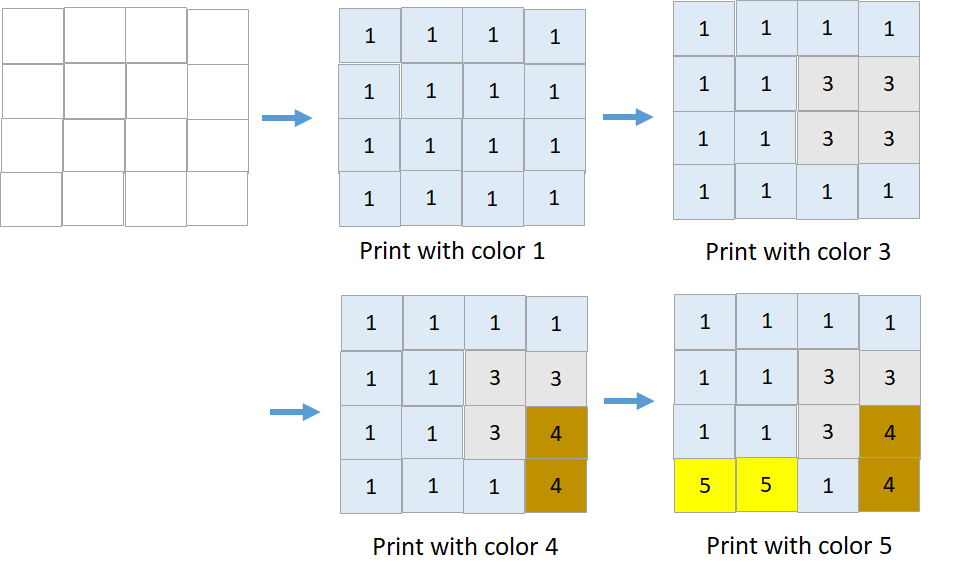 奇怪的打印机IIJava
奇怪的打印机IIJava
文章发布较早,内容可能过时,阅读注意甄别。
# 题目
给你一个奇怪的打印机,它有如下两个特殊的打印规则:
- 每一次操作时,打印机会用同一种颜色打印一个矩形的形状,每次打印会覆盖矩形对应格子里原本的颜色。
- 一旦矩形根据上面的规则使用了一种颜色,那么 相同的颜色不能再被使用 。 给你一个初始没有颜色的 m x n 的矩形 targetGrid ,其中 targetGrid[row][col] 是位置 (row, col) 的颜色。
如果你能按照上述规则打印出矩形 targetGrid ,请你返回 true ,否则返回 false 。
示例 1:

输入:targetGrid = [[1,1,1,1],[1,2,2,1],[1,2,2,1],[1,1,1,1]]
输出:true
示例 2:

输入:targetGrid = [[1,1,1,1],[1,1,3,3],[1,1,3,4],[5,5,1,4]]
输出:true
示例 3:
输入:targetGrid = [[1,2,1],[2,1,2],[1,2,1]]
输出:false
解释:没有办法得到 targetGrid ,因为每一轮操作使用的颜色互不相同。
示例 4:
输入:targetGrid = [[1,1,1],[3,1,3]]
输出:false
提示:
- m == targetGrid.length
- n == targetGrid[i].length
- 1 <= m, n <= 60
- 1 <= targetGrid[row][col] <= 60
# 思路
有向图采用邻接链表
# 解法
/*
1.将目标问题转换为有向图
在targetGrid中,首先求出每个像素的举行范围
在举行A中存在一个像素为B,则A应该先打印,B后打印,即A->B建立有向边,据此建立有向图
有向图采用邻接链表
顶点表示颜色
A->B表示颜色A先打印,颜色B后打印。颜色B在颜色A图层的上面
2.对有向图进行拓扑排序,有解,则说明可以从初始状态按照一系列打印规则打印到终止状态
*/
class Solution {
public boolean isPrintable(int[][] targetGrid) {
List[] adjList;
int[] top=new int[61];
int[] bottom=new int[61];
int[] left=new int[61];
int[] right=new int[61];
int color;
for(int i=1; i<=60; i++){
top[i] = 61;
bottom[i] = 0;
left[i] = 61;
right[i] = 0;
}
// 遍历图中的像素,求出每种颜色的矩形范围
for(int r=0; r<targetGrid.length; r++){
for(int c=0; c<targetGrid[0].length; c++){
color = targetGrid[r][c];
top[color] = Math.min(top[color], r);
bottom[color] = Math.max(bottom[color], r);
left[color] = Math.min(left[color], c);
right[color] = Math.max(right[color], c);
}
}
//建有向图
adjList=new List[61]; // 用邻接链表的方式表示有向图
boolean[][] haveEdge = new boolean[61][61]; // 判断是否已经有边,避免重复添加
int[] indegree = new int[61];
for(int i=1; i<=60; i++){
adjList[i] = new ArrayList<Integer>();
}
for(int r=0; r<targetGrid.length; r++){
for(int c=0; c<targetGrid[0].length; c++){
color = targetGrid[r][c];
for(int cl=1; cl<=60; cl++){
if(r>=top[cl] && r<=bottom[cl] && c>=left[cl] && c<=right[cl] && color!=cl &&haveEdge[color][cl]==false){
haveEdge[color][cl] = true;
indegree[cl]++;
adjList[color].add(cl);
}
}
}
}
// 进行拓扑排序,如果最后存在入度不为0的颜色,则不能打印
int count = 0;
Queue<Integer> queue = new LinkedList<>();
for(int i=1; i<=60; i++){
if(indegree[i]==0){
queue.offer(i);
}
}
while(!queue.isEmpty()){
color = queue.poll();
for(int i=0; i<adjList[color].size(); i++){
int c = (Integer)adjList[color].get(i);
indegree[c]--;
if(indegree[c]==0){
queue.offer(c);
}
}
}
for(int i=1; i<=60; i++){
if(indegree[i]>0){
return false;
}
}
return true;
}
}
1
2
3
4
5
6
7
8
9
10
11
12
13
14
15
16
17
18
19
20
21
22
23
24
25
26
27
28
29
30
31
32
33
34
35
36
37
38
39
40
41
42
43
44
45
46
47
48
49
50
51
52
53
54
55
56
57
58
59
60
61
62
63
64
65
66
67
68
69
70
71
72
73
74
75
76
77
78
79
80
81
82
83
84
85
86
87
2
3
4
5
6
7
8
9
10
11
12
13
14
15
16
17
18
19
20
21
22
23
24
25
26
27
28
29
30
31
32
33
34
35
36
37
38
39
40
41
42
43
44
45
46
47
48
49
50
51
52
53
54
55
56
57
58
59
60
61
62
63
64
65
66
67
68
69
70
71
72
73
74
75
76
77
78
79
80
81
82
83
84
85
86
87
# 总结
- 分析出几种情况,然后分别对各个情况实现


